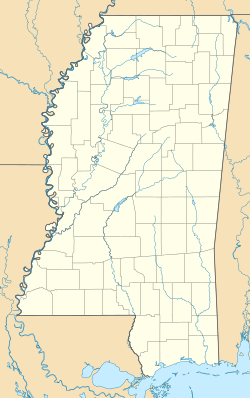St. Andrew's Cathedral (Jackson, Mississippi) facts for kids
Quick facts for kids St. Andrew's Cathedral |
|
|---|---|
 |
|
| 32°17′57.22″N 90°11′1.87″W / 32.2992278°N 90.1838528°W | |
| Location | 305 E. Capitol St. Jackson, Mississippi |
| Country | United States |
| Denomination | Episcopal Church |
| History | |
| Founded | 1839 |
| Architecture | |
| Style | Gothic Revival |
| Completed | 1903 |
| Administration | |
| Diocese | Diocese of Mississippi |
St. Andrew's Cathedral is a special Episcopal cathedral located in Jackson, Mississippi, United States. It serves as the main church for the Diocese of Mississippi. St. Andrew's is the third church to hold this important role in the diocese's history.
Contents
History of St. Andrew's Cathedral
Early Beginnings (1839-1863)
St. Andrew's started as a small mission in 1839. A clergyman, along with hymnals and prayer books, was sent from New York. At first, only eight people were part of the congregation. By 1843, St. Andrew's became a full parish of the Diocese of Mississippi. It was unique because it was the only parish not located along the Mississippi River at that time. Sadly, its first church building was burned down by the Union Army in 1863 during the American Civil War.
Building New Churches (1869-1903)
After the war, a new church was needed. The cornerstone for the second church was laid in 1869 by Bishop William Mercer Green. As the years passed, the congregation grew too large for this building. So, a third and much bigger church was completed in 1903. This is the beautiful building you see today.
Growth and Expansion (1923-1987)
The church continued to expand over the years. A Parish House, which is a building for church activities, was built between 1923 and 1924. In 1955, another building was constructed along West Street. The bishop's offices were moved into this new space. The area behind the church was turned into a peaceful courtyard. Later, in 1987, an additional wing was added to the east side of the church.
Becoming a Cathedral (1966)
For many years, Episcopal churches in the United States didn't often have cathedrals. The Diocese of Mississippi was similar. Its first cathedral was St. Peter's Church in Oxford. However, when Bishop Hugh M. Thompson moved to Jackson, he believed the cathedral should be in the city where he lived. So, St. Columba's Church became the diocesan cathedral for a while.
St. Andrew's grew to be the largest parish in the diocese. Because of its size and importance, it was officially made the cathedral on January 19, 1966. This made St. Andrew's the third church in the diocese to serve as the main cathedral.
Architecture of St. Andrew's Cathedral
Gothic Revival Style
St. Andrew's Cathedral was designed in the Gothic Revival style. This style brings back elements from medieval Gothic churches, like pointed arches and tall windows. When it was first built, the roof had fancy gables and trim, which was common for the late Victorian period. After a fire in 1930, these decorative parts were made simpler.
Inside the Church
The inside of the main worship area, called the sanctuary, has a cruciform shape. This means it looks like a cross when viewed from above, with a long central aisle and a crossing area. However, you can't see this cross shape from the outside because there are no transepts (side arms of the cross).
Originally, the church windows had amber-colored glass. Since the 1950s, these have been replaced with beautiful stained glass windows. Each of these new windows was given as a memorial to someone special.
Special Features and Symbols
The original altar, lectern (where readings are done), and pulpit (where sermons are given) were all made of carved wood. Later, a marble altar, a bronze angel, and a new pulpit were added as memorials. The church pews have a trefoil (a three-leaf clover shape) carved into their ends, which represents the Trinity. You can also find the X-shaped cross, called a saltire, in several places throughout the cathedral. This is the special symbol of St. Andrew, after whom the cathedral is named.
See also
- List of the Episcopal cathedrals of the United States
- List of cathedrals in the United States
- St. Andrew's Episcopal School (Mississippi)


